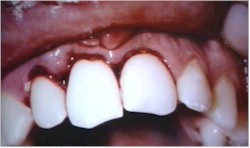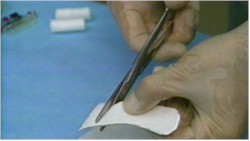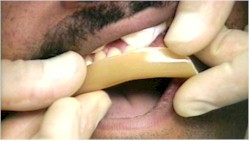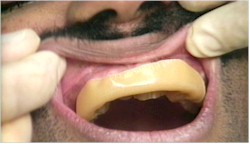|
|
||||
Lost TeethTeeth that are moved from their normal position but are still connected by soft tissue are called "extruded." These extruded teeth can be displaced: Teeth that have been displaced should be manipulated back into their original position in the alveolus (socket) and then stabilized. Stabilize the teeth using stomahesive. (See pictures) Recommend a soft diet, and then refer the patient to a dental officer as soon as possible. Teeth that have been moved completely out of the mouth are described as "avulsed." A tooth can often be successfully reimplanted if the socket is generally intact and the tooth out of the socket for no longer than about 30 minutes. If reimplantation seems like a good risk, rinse off any debris from the tooth, but don't scrape the roots. Remove the clot and any bone or tooth fragments from the mouth and socket. Position the tooth in the socket in what seems like the correct position. Press firmly enough to reseat it properly. Cut and apply stomahesive to hold the tooth in place. Depending on the circumstances, you may need to control pain, hemorrhage and infection following extrusion or avulsion of a tooth.
Stomahesive Application From "Dental Emergencies" Volume 803673 DN For additional information, read: "Dental Emergencies" in the General Medical Officer Manual. "Oral Diseases and Injuries" in the Hospital Corpsman 1 and C Manual.
Home · Military Medicine · Sick Call · Basic Exams · Medical Procedures · Lab and X-ray · The Pharmacy · The Library · Equipment · Patient Transport · Medical Force Protection · Operational Safety · Operational Settings · Special Operations · Humanitarian Missions · Instructions/Orders · Other Agencies · Video Gallery · Forms · Web Links · Acknowledgements · Help · Feedback Approved for public release; Distribution is unlimited.
*This web version is provided by The Brookside Associates, LLC. It contains original contents from the official US Navy NAVMED P-5139, but has been reformatted for web access and includes advertising and links that were not present in the original version. The medical information presented was reviewed and felt to be accurate in 2001. Medical knowledge and practice methods may have changed since that time. Some links may no longer be active. This web version has not been approved by the Department of the Navy or the Department of Defense. The presence of any advertising on these pages does not constitute an endorsement of that product or service by either the US Department of Defense or the Brookside Associates. The Brookside Associates is a private organization, not affiliated with the United States Department of Defense.
© 2015, Brookside Associates, LLC. All rights reserved |
|
|||








